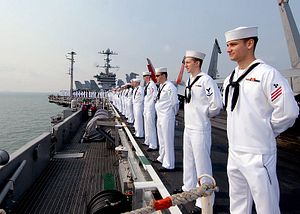Yesterday, The U.S. Navy, U.S. Coast Guard, and U.S. Marine Corps released a revised maritime strategy entitled “A Cooperative Strategy for 21st Century Seapower,” calling for all domain access, U.S. forward naval presence, and emphasizing cooperation between the United States and its allies in the face of various global maritime challenges (e.g., anti-access/area denial (A2/AD) capabilities of peer competitors). It also emphasized the growing importance of the Asia-Pacific region.
The document emphatically stresses the need for a fleet of at least 300 ships including 11 carriers, 33 amphibious ships, and 14 ballistic missile subs for the U.S. Navy and Marine Corps. It is important to note that this white paper is an unclassified public strategy. There are also classified annexes, unavailable to the public, outlining operational plans, specific tactics and likely opponents in more detail.
U.S. naval forces are facing a myriad of challenges on the world’s oceans. “Today’s global security environment is characterized by the rising importance of the Indo-Asia-Pacific region, the ongoing development and fielding of anti-access/area denial (A2/AD) capabilities that challenge our global maritime access, continued threats from expanding and evolving terrorist and criminal networks, the increasing frequency and intensity of maritime territorial disputes, and threats to maritime commerce, particularly the flow of energy,” the document underlines.
To face this perplexing 21st century threat environment, the strategy focuses on two foundational principles. First, forward naval presence is deemed essential to defend the homeland, deter conflict, respond to crises, defeat aggression, protect the maritime commons, strengthen partnerships, and provide humanitarian assistance and disaster response.
In detail this means that 120 ships will be forward deployed by 2020 (up from 97 in 2014) out of which 60 percent will be assigned to the Asia-Pacific region. This includes the U.S. Navy and Marine Corps most advanced, capable platforms such as the Littoral Combat Ships, Ballistic-Missile-Defense (BMD) capable vessels, F-35C Lightning II Joint Strike Fighters, MQ-4C Triton drones, and MV-22 Osprey squadrons. Outside the Asia-Pacific region, the Navy will increase the number of ships in the Middle East from 30 vessels today to 40 in 2020 and base four BMD-capable destroyers based in Spain by the end of 2015.
The Marine Corps will also maintain a Marine Expeditionary Force (MEF) in the Western Pacific and deploy troops to Australia. “Enhanced naval integration, compositing naval forces at sea, the use of nontraditional amphibious ships globally for the maritime force. There are points of emphasis that go from emphasizing warfighting to being where it matters when it matters,” stated Brig. Gen. Kevin Killea, director of the futures directorate and commander of the Marine Warfighting Lab.
Second, the strategy emphasizes joint operations with allies and partners. “Merging our individual capabilities and capacity produces a combined naval effect that is greater than the sum of its parts,” the document notes. Among other things, that means that U.S. naval forces will continue operating in standing NATO maritime groups, and participate in Cooperation Afloat Readiness and Training (CARAT) exercises held annually “to strengthen relationships and enhance force readiness.” “No one nation can do this alone. Every country can make a contribution no matter how small they are,” Rear Adm. Bill McQuilkin, director of Navy strategy and policy, stated last week.
A Breaking Defense article notes that the concept of all domain access – probably the most important element of the new strategy – has a very strong cyber component. The Breaking Defense piece also neatly summarizes the five pillars of all domain access, which is an outgrowth of the “Joint Concept for Access and Maneuver in the Global Commons” aka the “Air-Sea Battle” concept:
Battlespace awareness, which requires ‘persistent surveillance‘ of not only the physical environment but cyberspace and the electromagnetic spectrum as well.
Assured command and control, which requires US communications networks to operate reliably and securely in the face of enemy jamming and hacking. Gen. Dunford specifically said Navy-Marine networks aren’t up to coordinating the kind of dispersed operations that have become routine and will require new investment.
Cyberspace operations, “including both defensive and offensive measures.”
Electromagnetic Maneuver Warfare, a new Navy concept for masking friendly emissions — radar, radio, and so on — and deceiving or disrupting the enemy’s.
Integrated fires, which seeks to reduce reliance on a limited supply of expensive missiles by using jamming, hacking, lasers, and rail guns.
Rep. Randy Forbes (R) (perhaps a strategic hedgehog-tactical fox hybrid analyst), as I noted (see: “What Hawks Have to Say About the US Navy’s New Maritime Strategy”) yesterday – is pleased. “I don’t expect people on the Ways and Means Committee will rush down to get this maritime strategy and read it over the weekend,but I think what it does is help us paint the picture to these members about why it is important for us to turn the [trend] lines about what we’ve been doing on national defense,” he told Breaking Defense.

































